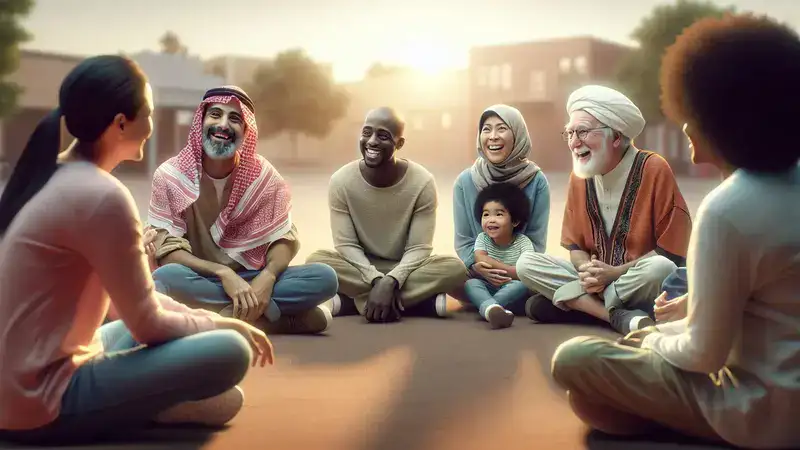Human gatherings have been a fundamental part of society since ancient times. Whether for social, cultural, or economic reasons, these gatherings bring people together. But in the modern age, with the rise of virtual events and social media, one question lingers: Is the human gathering fake? This article delves into the essence of gatherings and examines their authenticity in today’s world.
What Defines a is the human gathering fake?
Human gatherings vary widely. They can be small, intimate family reunions or large-scale festivals attended by thousands. These events serve many purposes: to celebrate, mourn, educate, or entertain. At their core, they are about human connection. But what makes a gathering authentic or fake? Is it the intention behind it, the way it is conducted, or the way it is perceived?
A genuine human gathering fosters connection, shared experiences, and sometimes a sense of belonging. However, modern gatherings are often questioned for their authenticity. With commercial interests and digital platforms increasingly shaping these events, some argue that many gatherings have lost their true essence. Contact us for more information.
The Impact of Technology on Gatherings
Technology has significantly altered how people gather. Virtual gatherings, facilitated by platforms like Zoom and Microsoft Teams, have become mainstream. These platforms emerged as essential tools during the COVID-19 pandemic, enabling people to connect despite physical distances. However, this shift towards virtual interaction has sparked debate over the authenticity of these meetings. Is the human gathering fake when conducted over a screen?
Virtual gatherings offer convenience and accessibility. They break down geographical barriers, allowing people from different corners of the world to come together. But they also lack certain elements of traditional gatherings, such as physical presence and non-verbal cues. These missing elements can make virtual interactions feel less genuine and more transactional.
Social Media’s Role in Shaping Perception
Social media profoundly influences how we perceive and participate in human gatherings. Platforms like Instagram, Facebook, and Twitter allow users to showcase their lives and the events they attend. This visibility can create a culture of comparison and performance. People might attend gatherings not for the experience itself, but to capture and share moments online.
This performative aspect of social media raises the question: is the human gathering fake when it’s driven by the need for social validation? When people curate their lives for public consumption, the line between genuine interaction and staged performance becomes blurred. The pressure to present an idealized version of life can lead to gatherings that are more about appearance than actual connection.
Are Corporate Gatherings Authentic?
Corporate gatherings such as conferences, seminars, and networking events have been scrutinized for their authenticity. These events are often seen as opportunities for professional advancement rather than genuine connection. Attendees may be more focused on self-promotion than on building meaningful relationships. This transactional nature can make these gatherings feel more like performances than true interactions.
However, not all corporate gatherings are inherently fake. Some offer valuable opportunities for learning, collaboration, and networking. The key difference lies in the intention behind the gathering. Is the event designed to facilitate genuine exchange, or is it a facade for commercial interests? This distinction is crucial in determining whether a human gathering is fake or authentic.
The Illusion of Connection in Modern Gatherings
Modern gatherings, both virtual and physical, often aim to foster a sense of connection. But some argue that this connection is superficial. In many cases, people attend events to be seen, to enhance their social status, or to capture the perfect photo for social media. This can create an illusion of connection without meaningful interaction.
When people focus on documenting experiences rather than fully engaging in them, the authenticity of the gathering is compromised. This behavior prompts us to question: is the human gathering fake when it prioritizes appearance over substance? The need to curate and share experiences online can detract from the genuine connections that gatherings are meant to facilitate.
Virtual Gatherings: A New Reality
The rise of virtual gatherings has redefined the concept of human interaction. These events are convenient and accessible, allowing people to participate from anywhere in the world. However, they also raise questions about the quality of interaction they offer. Can virtual gatherings provide the same level of engagement and connection as physical ones?
While virtual gatherings lack physical presence, they can still be meaningful. They offer a platform for dialogue, learning, and networking. Yet, the absence of face-to-face interaction can limit the depth of connection. This leads to a broader question: is the human gathering fake when it’s conducted in a virtual environment? The answer is not straightforward, as the authenticity of a gathering depends on the nature of interaction and engagement it fosters.
Consumerism and Its Influence on Gatherings
Consumerism has a significant impact on the nature of human gatherings. Large festivals, conventions, and even smaller events are often commercialized. Sponsors, advertisers, and merchandise are integral parts of these gatherings. This commercialization can make events feel more like marketing opportunities than genuine social experiences.
The consumerist influence can lead to gatherings that prioritize profit over connection. For instance, music festivals might focus more on selling tickets and merchandise than on creating a meaningful experience for attendees. In such cases, is the human gathering fake if it’s driven by commercial interests rather than genuine engagement?
The Performative Nature of Modern Gatherings
Some argue that human gatherings have become performative. People attend events not necessarily to connect but to display their social lives. They take photos, post them online, and seek validation from likes and comments. This performative aspect can make gatherings feel less authentic, as the focus shifts from genuine interaction to creating a curated image.
Performative behavior is particularly evident in the age of social media. People feel compelled to present their best selves and showcase their social experiences. This raises the question: is the human gathering fake when it’s more about the display than the experience? The need for social validation can overshadow the original purpose of gathering, which is to connect and share with others.
The Cultural Context of Gatherings
Cultural factors play a significant role in shaping the nature of gatherings. In some cultures, gatherings are sacred and deeply meaningful. They serve as rituals that strengthen communal bonds and convey shared values. In others, gatherings might be more casual and frequent, serving as a regular part of social life.
The meaning of a gathering can vary greatly depending on cultural context. For some, a gathering might be a solemn occasion, while for others, it’s an opportunity for celebration. This cultural diversity adds complexity to the question: is the human gathering fake? What might be considered a genuine gathering in one culture could be seen as performative in another.
The Desire for Authenticity
Despite concerns about the authenticity of modern gatherings, there is still a strong desire for genuine connection. People crave interactions that are meaningful and enriching. This desire has led to the rise of smaller, more intimate gatherings, where people can connect on a deeper level.
These smaller gatherings focus on quality over quantity. They offer an environment where people can engage in meaningful conversations and share experiences. This trend suggests that while some gatherings may feel fake, there is still a place for authentic connection in today’s world.
Can Gatherings Be Both Real and is the human gathering fake?
The complexity of human gatherings suggests they can be both real and fake. An event can offer genuine opportunities for connection while also being influenced by external factors like consumerism and social media. For example, a conference might have a commercial aspect but still provide valuable networking and learning experiences.
Similarly, a music festival might be sponsored by major brands, yet it can create a sense of community and shared joy among attendees. The key is to recognize that authenticity is not a binary concept. It exists on a spectrum, and a gathering can have elements of both reality and facade.
The Future is the human gathering ?
The future of human gatherings is evolving, especially with advancements in technology. Virtual reality and augmented reality are likely to become more integrated into how we gather. These technologies have the potential to make virtual gatherings more immersive and interactive, blurring the lines between the real and the digital even further.
As technology continues to shape human interaction, the question “is the human gathering fake?” will remain relevant. However, the fundamental human desire for connection will continue to influence how gatherings evolve. People will seek out experiences that offer genuine interaction, whether in physical spaces or virtual environments.
Conclusion: is the human gathering fake?
Is the human gathering fake? The answer is multifaceted. Gatherings can be authentic or inauthentic, real or performative. They can offer genuine connection while being influenced by consumerism and social media. As we navigate this complexity, the key is to seek gatherings that align with our values and provide meaningful experiences.
By being mindful of the nature of the gatherings we participate in, we can make more conscious choices. This involves looking beyond the surface and focusing on the quality of interactions. Whether in person or online, gatherings will always be a part of human life. The challenge lies in finding and creating those that foster true connection.
Summary is the human gathering fake
Is the human gathering fake are evolving, influenced by technology, consumerism, and cultural shifts. While some gatherings are seen as inauthentic, the human desire for real connection persists. By understanding what influences gatherings and being intentional about how we engage in them, we can find more meaningful ways to connect.
Tips for Authentic Gatherings
- Seek Purposeful Gatherings: Look for events that have a clear purpose and align with your personal values.
- Focus on Quality Interactions: Prioritize smaller gatherings that allow for deeper engagement over large, impersonal events.
- Be Mindful of Your Intentions: Attend gatherings for the experience and connection, not just for social media or status.
- Engage Actively: Be present and engage genuinely with others, rather than focusing on capturing the moment.
- **Evaluate the Setting


Your point of view caught my eye and was very interesting. Thanks. I have a question for you.
Thank you for your sharing. I am worried that I lack creative ideas. It is your article that makes me full of hope. Thank you. But, I have a question, can you help me?
I don’t think the title of your article matches the content lol. Just kidding, mainly because I had some doubts after reading the article.
Reading your article helped me a lot and I agree with you. But I still have some doubts, can you clarify for me? I’ll keep an eye out for your answers.